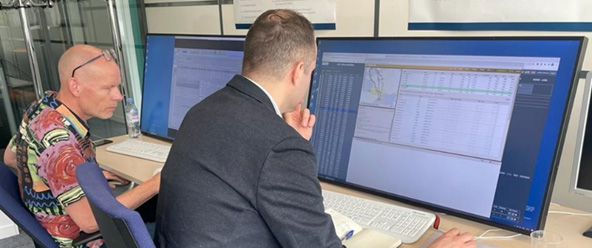In May, SESAR 3 JU members AIRBUS, DASSAULT AVIATION, DSNA, ENAV, EUROCONTROL and THALES validated a solution to enhance trajectory planning processes and tools used by airspace users, the Network Manager and air navigation service providers within the context of the Optimised Airspace Users Operations (OAUO) project. The aim is the increase the predictability of air traffic in Europe’s airspace.

Airspace users have varied business priorities, yet airspace management provides limited flexibility for users to incorporate specific aircraft or flight priorities into the requested trajectory. SESAR is researching ways to integrate processes within the flight operations centre (FOC), which help to manage and update the shared business trajectory with ATM network processes. This increases the FOC’s role with regard to planning trajectory management, and investigates the impact of such integration on all stakeholders.
The main objectives of the SESAR solution (PJ.07-W2-38) are:
- To better manage critical flights to reduce the costs of air traffic flow and capacity management (ATFCM) delays;
- To define short-term evolutions for improving trajectory planning taking into account the needs of airspace users (AU), the network and local flow management;
- To pave the way towards the automation of collaborative trajectory planning processes, a key pre-requisite for trajectory-based operations
In order to meet the objectives, three concepts were validated during the exercise:
- AU provision of the flight delay criticality information to the Network Manager (NM) and air navigation service providers (ANSPs), proactively: this concept allows airlines to tag certain flights as critical to their operation allowing NM and local flow managers to take better decisions to reduce the cost of ATFCM delays.
- Protection hotspot declarations by a flow management position (FMP) to warn airspace users that a certain sector is becoming congested. This improves trajectory planning and increase network stability by preventing a significant proportion of ineffective re-filings to avoid ATFCM delays.
- Integration of flow management information, including protection hotspots into the AU flight planning systems: this improves user situational awareness and workflow for the optimisation of the planned trajectory. It is also a key step toward the automation of collaborative trajectory planning processes.
The validation exercise, managed by EUROCONTROL, was performed in highly realistic conditions considering live traffic and network situation. Exceptional network situation with heavy delays was also simulated.
The validation scenarios were executed on the 5-6 May and 12-13 May by participants from AIR FRANCE, AIR BALTIC, DASSAULT AVIATION, EL AL, RYANAIR, SWISS, and TRANSAVIA as Airspace Users. On the ANSP side, DSNA and ENAV participated. The NMOC role was played by EUROCONTROL NM.
The validation exercise paid particular attention to the human performance aspects such as situational awareness of the AUs, ANSPs and Network Manager as well as system interoperability.
The validation platform consisted of prototypes developed by DASSAULT AVIATION, METRON AVIATION, NAVBLUE, SWISS, THALES AIR SYS and EUROCONTROL. All prototypes were connected in real-time via the SWIM compliant NM B2B web services.
Four different prototypes were developed for airspace users to address different categories of users (e.g. major airlines, business aviation) and topics:
- The NAVBLUE prototype addressed the optimisation of flight planning considering flow management constraints and information (protection hotspots)
- METRON AVIATION and SWISS prototypes allowed the monitoring and sharing of information related to critical flights
- The DASSAULT AVIATION prototype addressed the flow management constraints integration and critical flights functions by focusing on business aviation needs
The prototype developed by THALES was used by Italian FMPs for the management of protection hotspots and critical flights.
EUROCONTROL provided the Network Management Validation Platform (NMVP) and human interfaces for NM operators and French FMPs.
The solution team collected data during the exercise. Examples of such data are the actor’s decisions and reasons, trajectory and traffic evolution throughout the scenarios and situational awareness. This data is now being evaluated by the solution team.
The solution team expects to reach V3 maturity level by the end of 2022 paving the way towards implementation.

Solution 38 Prototypes screenshots
This project has received funding from the SESAR Joint Undertaking under the European Union's Horizon 2020 research and innovation programme under grant agreement No 874470
